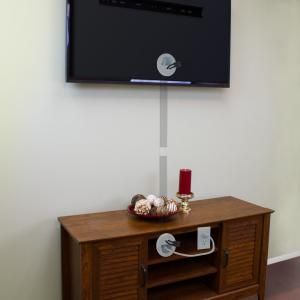National electrical code 400 8 rolls through the things you can t do with cord and it s mostly a list of schemes to use them as a substitute for the permanent wiring of a structure.
Run power cord behind wall.
When i say power cables i mean power cables for televisions receivers etc.
Because we re only making an in wall extension cord there isn t any reason to turn off the power.
Of course it s illegal to run power cords inside walls.
The included extension cable connected to the lower.
You should not run power cables through a wall as a substitute for permanent wiring ie wired outlets.
For more on this.
1 as a substitute for the fixed wiring of a structure 2 where run through holes in walls structural ceilings suspended ceilings.
Feed the wires through the retro fit single gang box and then screw in the screws to secure them.
The most common cable management systems conceal wires behind molded plastic raceways that run along the walls and baseboard.
Flexible cords and cables shall not be used for the following.
Dragging extension cords across the yard to power the weed whip fumbling around in a dark shed most of us take these hassles for.
3 where run through doorways windows or similar openings.
Luckily there are code approved installation kits for running power up inside a wall that do not require and electrician.
Running extension cords from one end of a room to another and even through walls can be very easy and a good solution for putting appliances exactly where you want them.
Data cables on the other hand can go right into the wall cavity.
See our blog post why does running a power cord behind the wall for a wall mounted tv violate the electrical code.
The only power cable you should run behind your wall are ones that come in a code friendly kit.
By following a few simple steps you can run power from one room to another and economically get all the electrical power you need to the places where you need it.
It s actually against one of the articles in the nec.
Not actual electrical wires romax.
I would strongly suggest not running power cables through any walls.
Run electrical wires underground to reach sheds lights patios and other locations following safe wiring practices.
While these can clean up things immensely there are other slightly more involved but still easy to install systems that allow the cables to be run behind walls.
An extension cable to run to an existing outlet.










